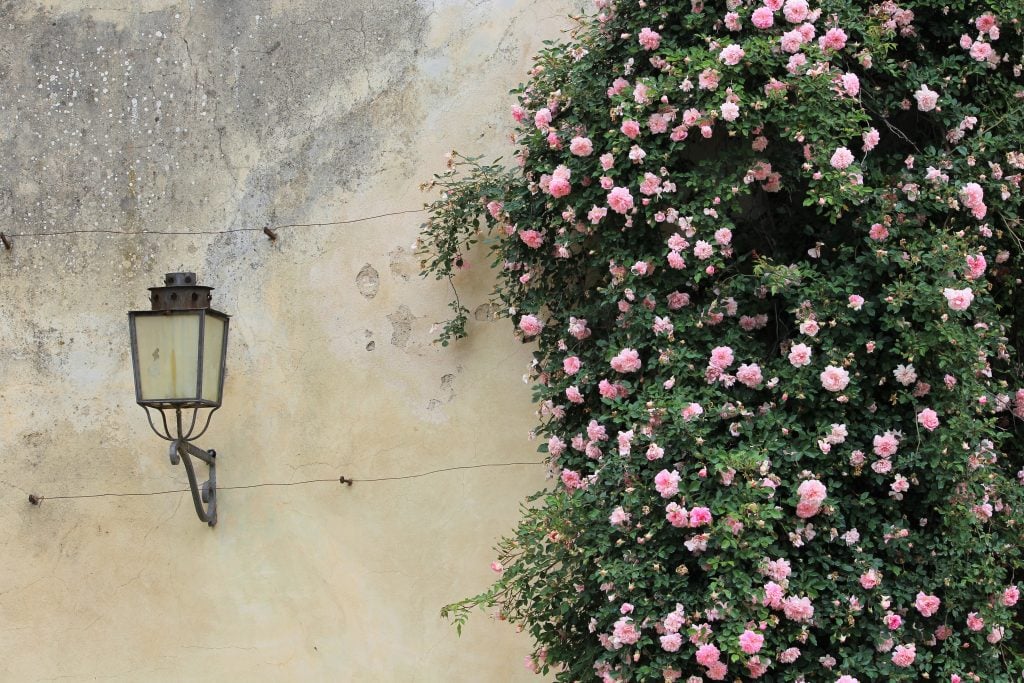Table of Contents
Deep in the beauty of a shady garden, there is a hidden quest for gardeners to choose the right flowers for it! A smart combination of plants can offer vibrance and contrast to a garden. Climbing flowers prove to be a fantastic choice for these shady areas. They not only make the wall look taller but also give a colourful definition or, say, an outline to them.
If we start talking about the benefits of having the climbers for shade, then it would take us an entire hour! They are not only beautiful, but also they are effortless to grow and need too less maintenance. This is an ideal choice for those gardeners who usually have a hectic schedule.
How to Choose the Right Climbers for You
Numerous variables should be brought to attention when selecting climbing vegetation for shaded areas. First and Foremost, the degree of shade in your garden should be taken into account. Certain plants can tolerate profound shade, while others necessitate some sunlight.
In addition, it is crucial to consider the size of the vegetation and the space it will necessitate to thrive. A number of climbing plants can exceptionally grow too big and will require an enormous amount of space to expand and propagate.
Lastly, it is vital to take into account the growth conditions present in your garden, such as the type of soil and drainage. A few plants favour well-draining soil, while others prefer moist soil.
List of 20 Best Climbing Plants For Shade
1. Honeysuckle
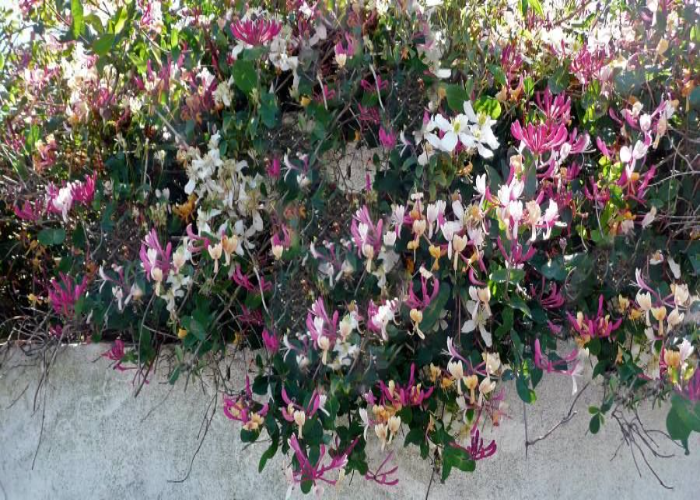
Honeysuckle flowers are frequently cultivated as climbers of shrubs. They grow in full sun exposure or partially shaded regions. Their blooming period usually ranges between the end of spring and the beginning of autumn. Their height can reach an impressive 30 feet. Adequate and routine hydration is necessary, especially during ward conditions.
Botanical name: Lonicera
Colour options: These climbers offer us a variety of colours from which you can choose. A combination of pink and white looks amazing on the wall with a slightly yellowish tint. However, if you have a different-coloured wall, you can try other colours. The options available are-
- Red
- White
- Yellow
- Pink
Soil requirement: These flowers need soil that drains excess moisture and is rich in organic matter and nutrients.
2. Jasmine
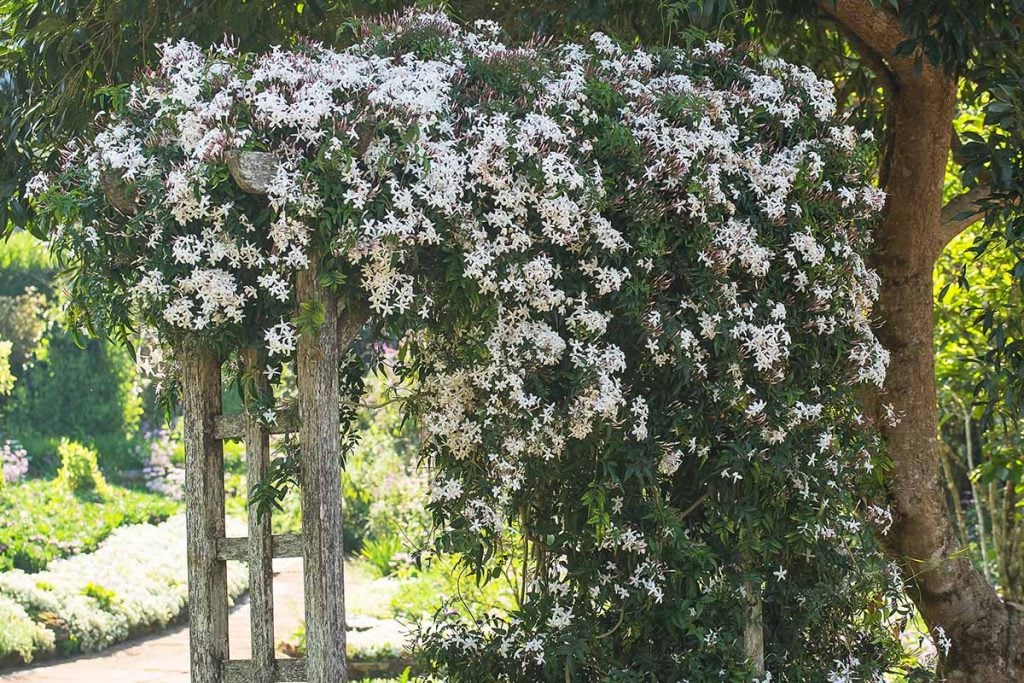
Jasmine flowers are frequently cultivated as climbers or shrubs. They flourish optimally in complete exposure to sunlight or in environments that are partially shaded. Their blooming season usually spans from the end of spring until the commencement of autumn. Their maximum height can reach up to 15 feet! Adequate and routine watering is preferred, especially during the summer season.
Botanical name: Jasminum
Colour options: Although these flowers have less variety, they can mesmerise someone’s mind with their beauty. The colour options available are-
- White
- Yellow
Soil requirement: Jasmine needs competitively more acidic soil rich in organic matter, and also well-draining soil is ideal.
3. Clematis
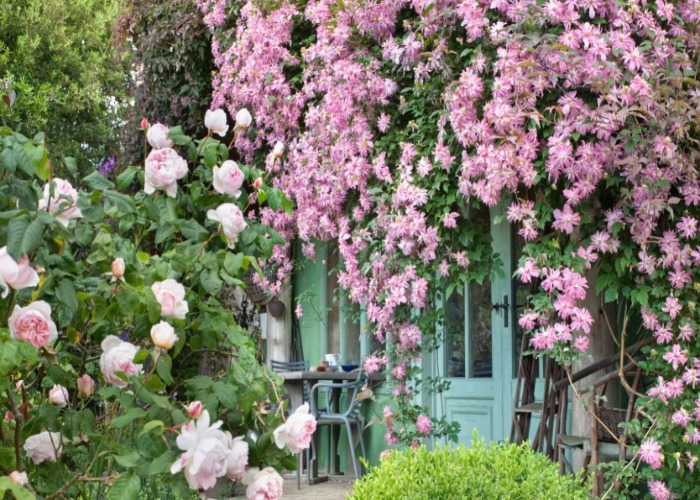
Clematis Flowers are grown as climbers or wine and thrive best when subjected to complete exposure to sunlight or partial shading. These flowers have their blooming period starting from spring until the onset of autumn. Their total length can extend up to a massive 30 feet!
Botanical name: Clematis
Colour options: These climbers have one of the most diverse colours on the entire list! You can create vibrant combinations with these to make your walls eye-catching and a great conversation starter with someone you have met recently! The colour options are-
- Pink
- Purple
- Red
- White
- Blue
Soil requirement: Clematis need soil that drains excess moisture and is rich in organic matter and nutrients. Loamy soil is preferred.
4. Wisteria
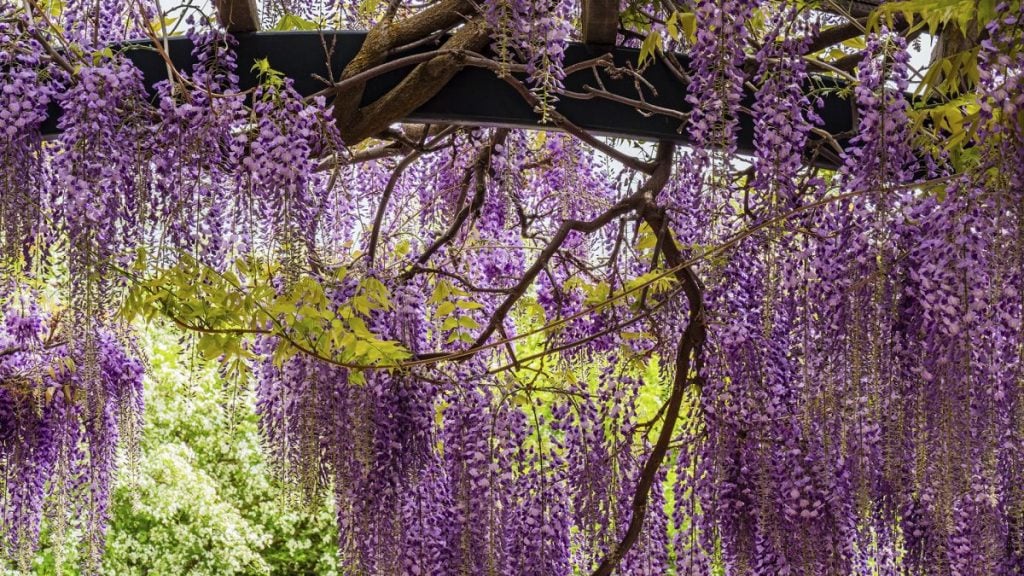
Wisteria flowers are frequently cultivated as climbers and attain their optimal growth under full sunlight or partially shaded zones. Their blooming period usually transpires between the end of spring and the early part of summer, and their length can reach an imposing 30 feet! Regular watering, particularly during hot climatic conditions.
Botanical name: Wisteria
Colour options: Wisteria offers a large variety of colours. However, unlike other flowers, they have absolutely contrasting colours, which is suitable for those who need a change. The colour option available are-
- Blue
- Pink
- Purple
- White
Soil requirement: Their preference lies with soil that easily drains excess water. It should be rich in organic matter and nutrients. Loamy soil is preferred.
5. Climbing Rose
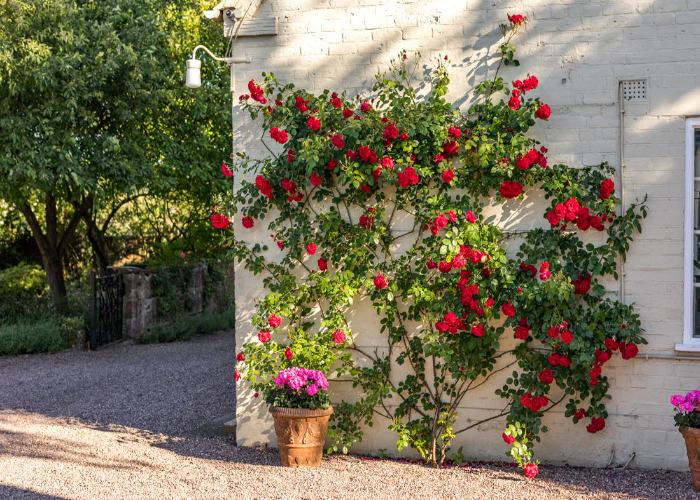
Roses are grown as shrubs or climbers. They achieve their optimal growth when they are completely exposed to sunlight. Their blooming season extends from the end of spring until the onset of autumn. Their height can reach up to 10 feet, and they need regular watering, especially during hot and dry climates.
Botanical name: Rosa
Colour options: Roses, too, have one of the most diverse colours in the entire list. You can create vibrant combinations with these to make your walls eye-catching and a great conversation starter with someone you have met recently. Most importantly, they are easy to maintain and are most commonly used at weddings. The colour options are-
- Red
- Pink
- White
- Yellow
- Orange
- Black
Soil requirement: Roses, too, need soil that drains excess moisture and is rich in organic matter and nutrients. Loamy soil is preferred.
6. Ivy
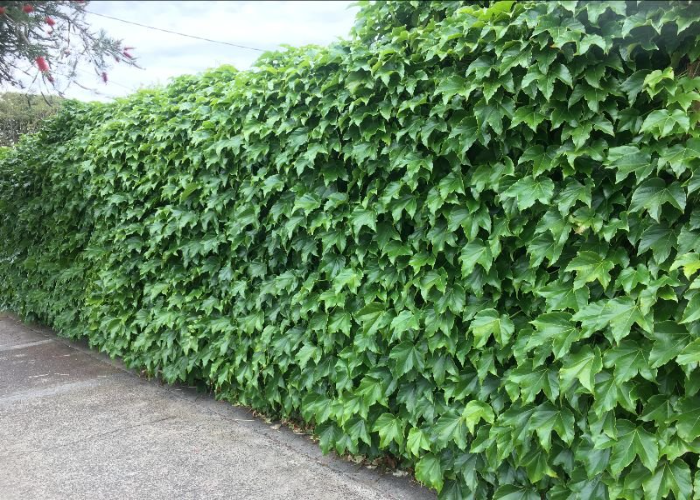
Ivy is a swiftly growing creeper and is capable of reaching a towering height of up to 50 feet! It is an evergreen flower that has a blooming season during the autumn season. Ivy is renowned for its undemanding maintenance and can thrive with regular watering and moderate exposure to sunlight.
Botanical name: Hedera helix
Colour options: Its colours can usually be combined with other plants. However, you can put them on your window, giving your room a nice and natural appeal. The colour options are as follows-
- Green
- Shades of green
Soil requirement: Well-draining soil is required for optimum growth and survival.
7. Trumpet Vine
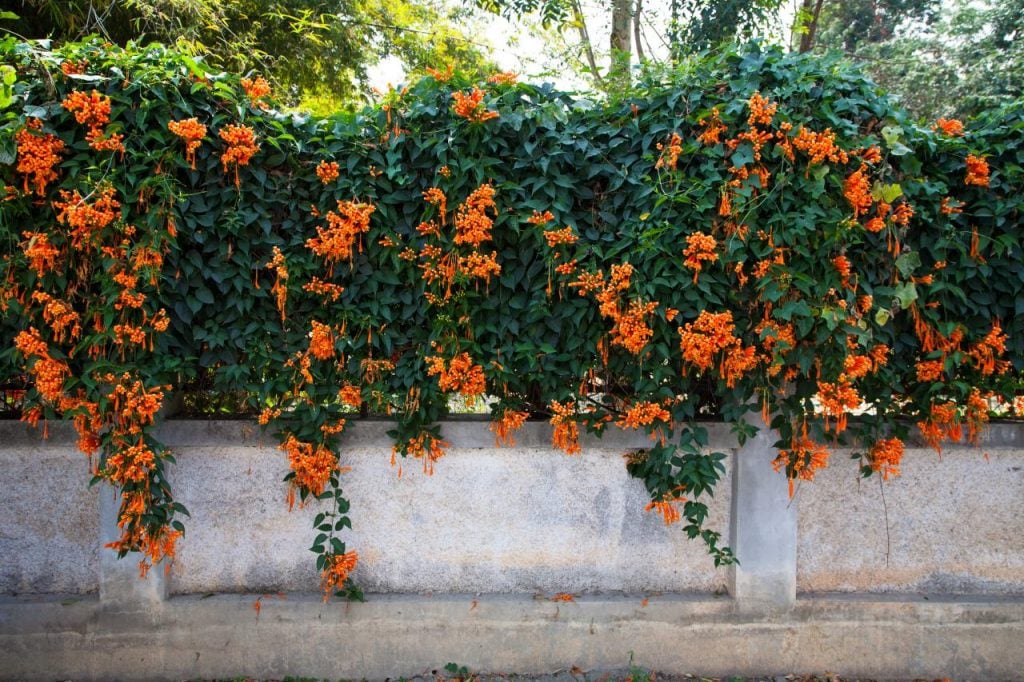
The Trumpet vine is a rapid-growing climbing flower. It is capable of attaining soaring heights up to 40 feet! This flower produces vivid, trumpet-shaped flower which looks mesmerising. Trumpet vine requires a moderate watering routine and the radiance of full sun exposure.
Botanical name: Campsis radicans
Colour options: Trumpet Vine comes in three different colours. However, they range from yellow to red. These amazing flowers have the ability to calm your mind and give out happy and energetic vibes all around. The options available are-
- Orange
- Red
- Yellow
Soil requirement: Trumpet Vine needs soil that drains excess moisture and is rich in organic matter and nutrients.
8. Climbing Hydrangeas
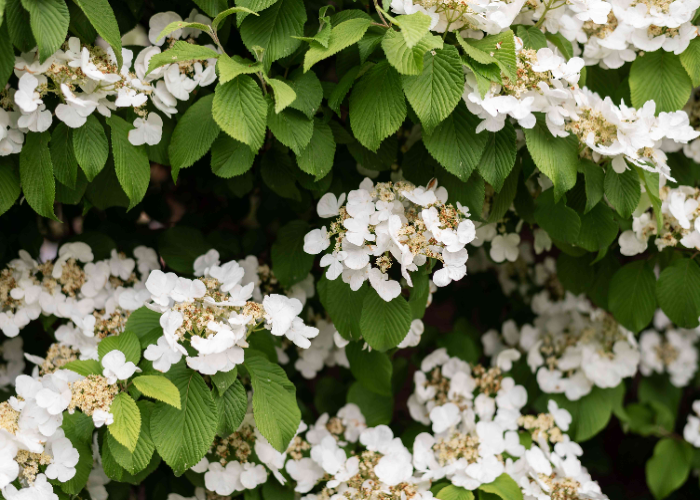
The climbing hydrangea is a slow leisurely-growing climber. It has the potential to reach a loft height of 50 feet! During the summer, it produces sizeable, sweet-smelling flowers of white shade. The climbing hydrangeas need moderate watering and warm and partial sunlight to thrive.
Botanical name: Hydrangeas petiolaris
Colour options: Climbing Hydrangeas do not show much variety in terms of colours. However, even this colour is enough to get someone’s attention passing by your house. The colour option available is-
- White
Soil requirement: Hydrangeas need soil that drains excess moisture and is rich in organic matter and nutrients.
9. Passionflower
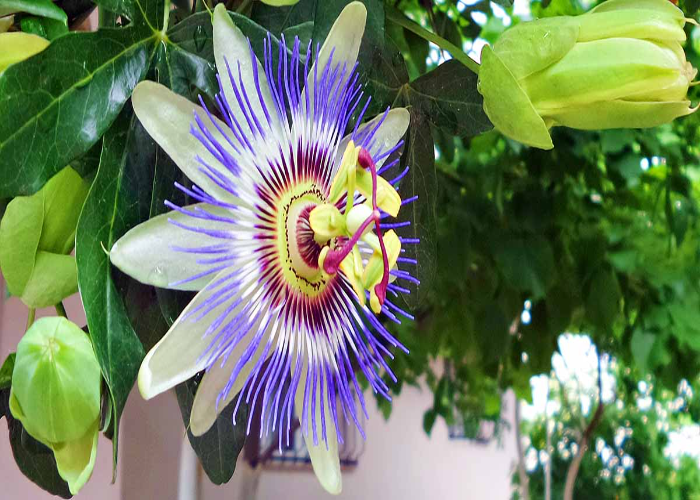
Passionflower is a climber and is capable of reaching up to thirty feet tall. This wonderful flower’s blooming season starts from the end of the spring till the beginning of autumn. Adequate watering and exposure to partial or full sunlight are crucial elements that promote this exceptional flower’s optimal growth and health.
Botanical name: Passiflora Incarnata
Colour options: These climbers offer us a variety of colours from which you can choose. A combination of pink and white looks amazing on the wall with a slightly yellowish tint. However, if you have different-coloured walls, you can try other colours. The options available are-
- Pink
- White
- Purple
Soil requirement: Passionflower has a need for well-draining soil that is abundant in organic matter. Though it can germinate in a range of soil types, it thrives best when planted in slightly acidic to neutral soil with a pH of approximately 6.0 to 7.0.
10. Virginia Creeper
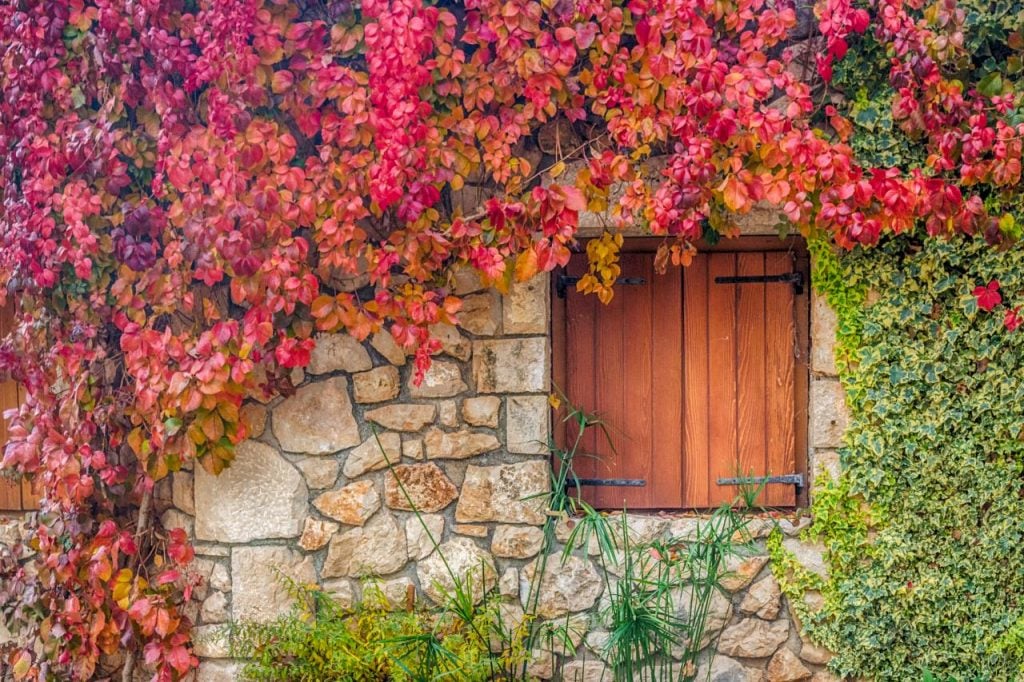
Virginia Creeper, a rapidly-growing vine, can reach an impressive height of up to 50 feet. During the summer, it generates petite greenish-white flowers, which are succeeded by blue-black berries during autumn. For this exquisite flora to thrive and flourish, it necessitates a moderate amount of watering and exposure to partial shade or full sunlight.
Botanical name: Parthenocissus quinquefolia
Colour options: Virginia creepers do not show much variety in terms of colours. However, even these few colours are enough to get someone’s attention passing by your house. The colour option available is-
- Green
- Red (In fall)
Soil requirement: Virginia Creeper needs soil that drains excess moisture and is rich in organic matter and nutrients.
11. Kiwi Fruit
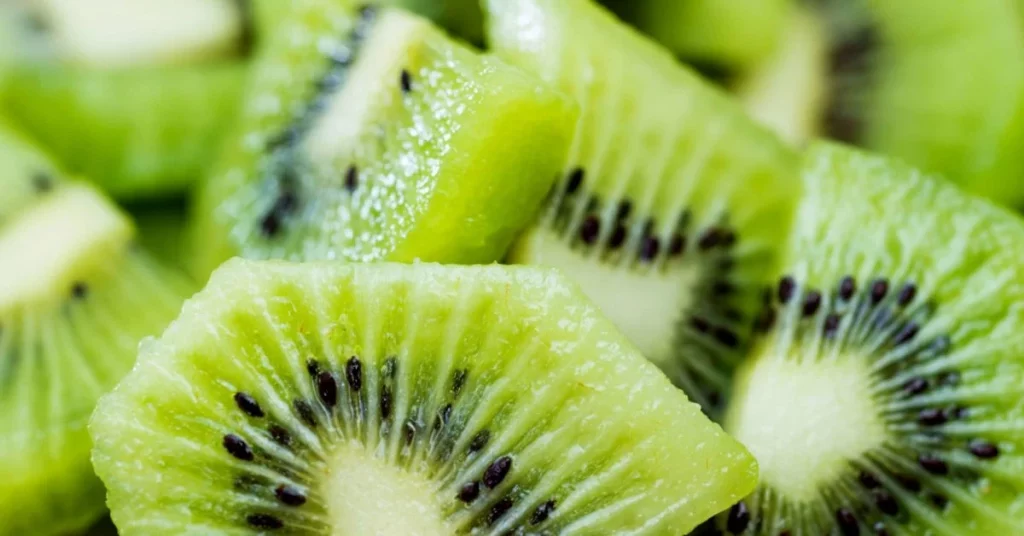
The kiwi is a fast-growing plant. In fall, it yields a bounty of delectable fruit that is beloved by many. It’s a flower that spreads white flower that feels nice to both eyes as well as the nose! They can reach a height of up to 20 feet.
Botanical name: Actinidia deliciosa
Colour option: Kiwis do not show much variety in terms of colours. However, the fruit is enough to bring a smile to your face while eating it. The colour option available is-
- White
Soil requirement: Kiwi needs soil that drains excess moisture and is rich in organic matter and nutrients.
12. Pyracantha
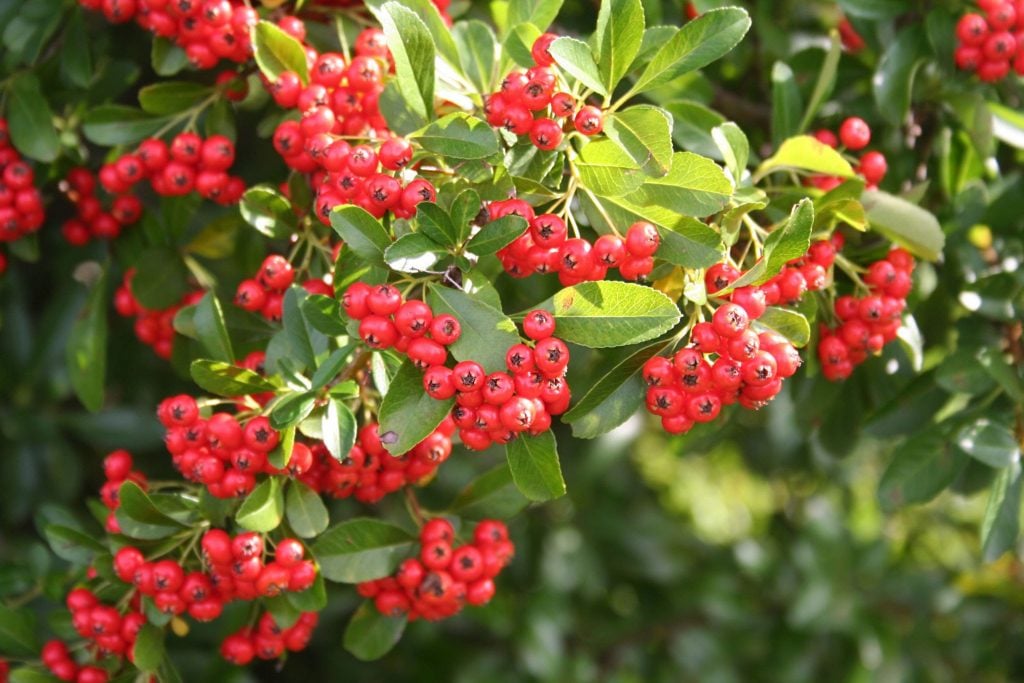
Pyracantha, a thick and prickly vine-like shrub, has the potential to reach a towering height of up to 13 feet. During the summer period, it produces white flowers, which are succeeded by striking red or orange berries during the fall season. For this flora to thrive and achieve optimal growth, it requires a moderate amount of watering and full exposure to sunlight.
Botanical name: Pyracantha coccinea
Colour option: These climbers offer us a variety of colours from which you can choose. A combination of red and white looks amazing on the wall with a white tint. However, if you have different-coloured walls, you can try other colours. The options available are-
- White
- Red
- Orange
Soil requirement: Pyracantha needs soil that drains excess moisture and is rich in organic matter and nutrients.
13. Russian Vine
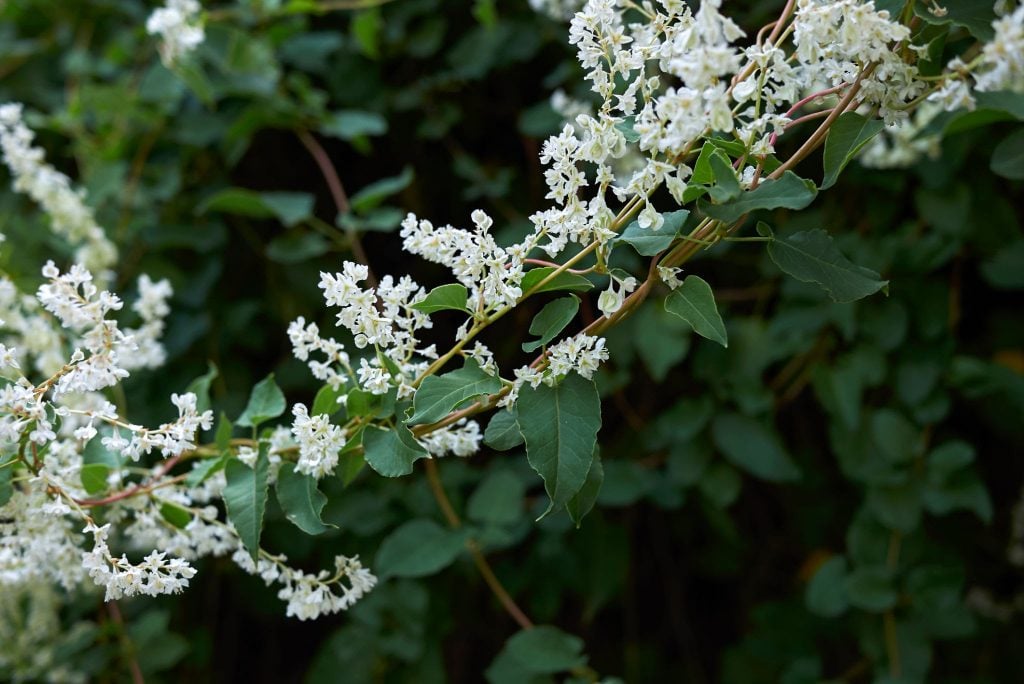
Russian Vine, a fast-developing climbing plant, can rise to a remarkable height of up to 33 feet. During the summer period, this plant blossoms with small white flowers, and in the autumn season, it yields dark brown berries. Adequate watering and full exposure to sunlight are essential components that contribute to the successful growth and development of the Russian Vine.
Botanical name: Fallopia Bald Schuanica
Colour option: Russian Vine does not show much variety in terms of colours. However, the fruit is enough to bring a smile to your face while eating it. The colour option available is-
- White
Soil requirement: Russian Vine has a need for well-draining soil that is abundant in organic matter. Though it can germinate in a range of soil types, it thrives best when planted in slightly acidic to neutral soil with a pH of approximately 6.0 to 7.5.
14. Grapevine
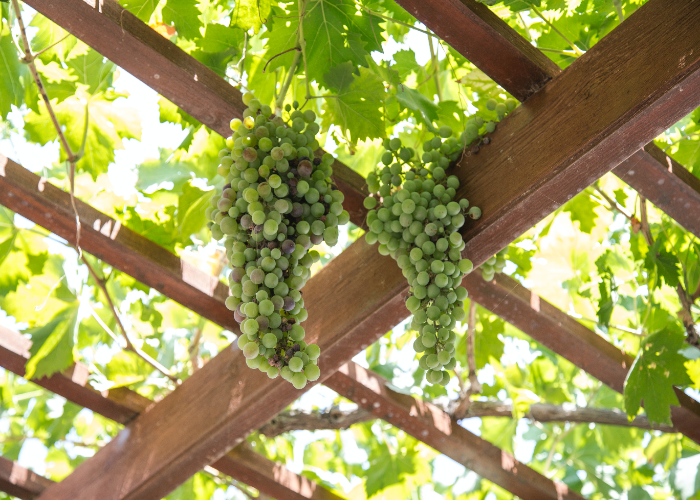
The grapevine is a swift-growing climber. During the summer, this plant creates sweet-smelling flowers that give way to appetising fruit during the fall. For the grapevine to flourish, it is important to water it consistently to give full sun exposure. It can reach heights of up to 30 feet.
Botanical name: Vitis vinifera
Colour option: These climbers offer us a variety of colours from which you can choose. A combination of red and purple looks amazing on the wall with a black shade. However, if you have different-coloured walls, you can try other colours. The options available are-
- Green,
- Red
- Purple
Soil requirement: Grapevine flowers need soil that drains excess moisture and is rich in organic matter and nutrients.
15. Climbing Beans
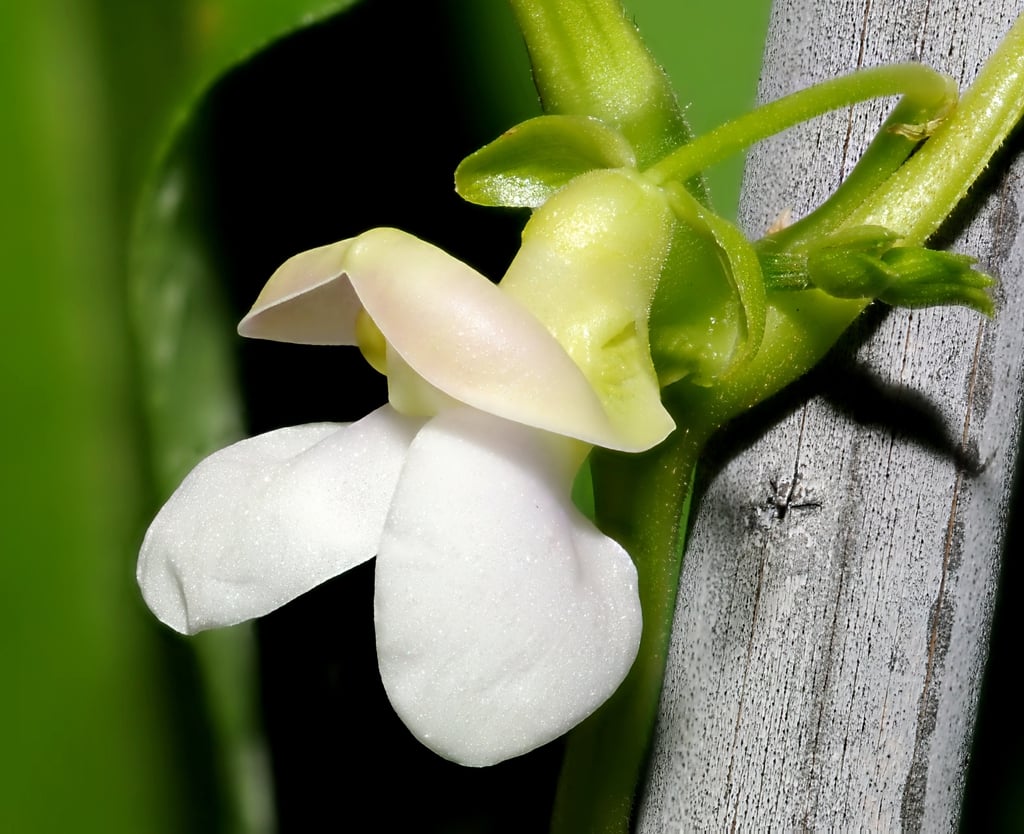
Climbing beans are rapid-growing flora that can attain a height of 8 feet. These plants yield edible beans and benefit from serving as decorative vegetation due to their appealing flowers. Generally, climbing beans blossoms from mid-summer until the commencement of fall. In order for these plants to thrive, it is important to provide them with consistent water, particularly during hot weather conditions. Maintaining moisture in the soil is crucial while preventing waterlogging is equally vital. Maintaining climbing beans is relatively undemanding. It is essential to prune them regularly to regulate their development and promote proper air circulation around the plant.
Botanical name: Phaseolus vulgaris
Colour option: Climbing beans have the ability to produce a diverse array of colourful flowers, such as-
- White
- Pink
- Red
- Purple
Soil requirement: Climbing beans have a need for well-draining soil that is abundant in organic matter. Though it can germinate in a range of soil types, it thrives best when planted in slightly acidic to neutral soil with a pH of approximately 6 to 6.8.
16. Black-eyed Susan
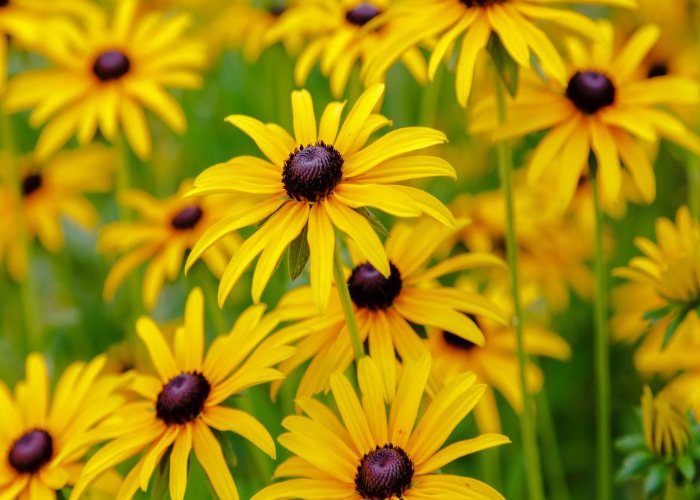
Black-eyed Susan is a fast-growing climber. Its total length can vary from plant to plant. However, it can reach a length of up to 3 feet. During the summertime and autumn, it produces yellow flowers that have a black core. The black-eyed Susan is known to be a less demanding flower that needs moderate watering and an ample amount of sunlight. It can be maintained with ease and needs rare pruning to promote its growth.
Botanical name: Rudbeckia hirta
Colour option: These climbers don’t have any options to choose from. However, only one is enough to brighten your mood every morning. The colour in which it comes in is-
- Yellow with a black core
Soil requirement: The black-eyed Susan has a need for well-draining soil that is abundant in organic matter. Though it can germinate in a range of soil types, it thrives best when planted in slightly acidic to neutral soil with a pH of approximately 5.5 to 7.0.
17. Climbing Geraniums
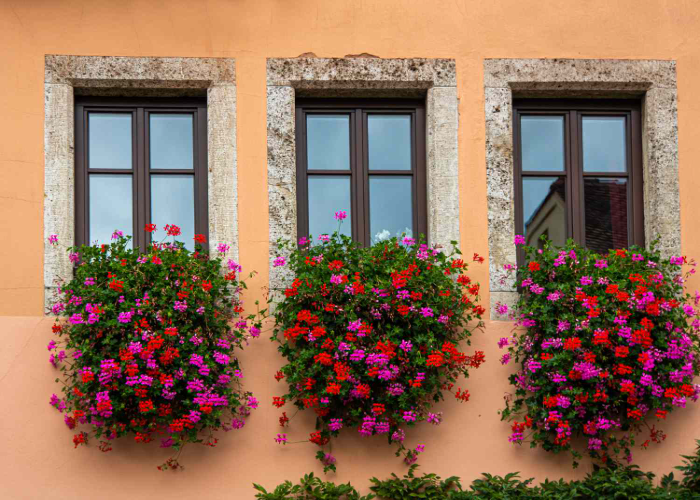
Climbing geraniums are rapid-growing flowers that are capable of reaching a height of up to six feet. These plants produce aromatic blooms in summer and fall. These plants need moderate watering and full sun exposure to thrive. Due to their low-maintenance requirements, they are simple to care for.
Botanical name: Pelargonium peltatum
Colour option: Climbing Genranums have the ability to produce a diverse array of colourful flowers, such as-
- Pink
- Red
- White
- Blue
Soil requirement: Climbing Genranums need soil that is well-draining and enriched with organic matter. These plants can thrive in diverse soil types but excel when planted in soil that is slightly acidic with. a pH range of approximately 6.0 to 6.5.
18. Climbing Nasturtiums
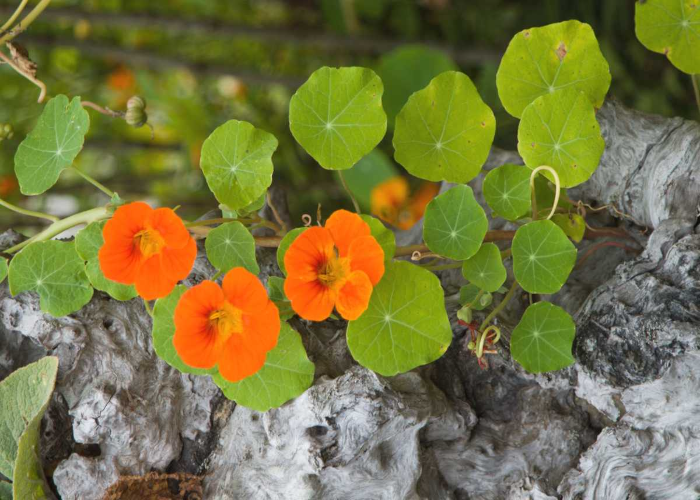
Climbing Nasturtiums are rapid-growing flowers. They can reach a total length of up to 10 feet. This flower blossoms during summertime and autumn. For optimal growth, climbing nasturtiums needs moderate irrigation and abundant exposure to full sunlight or partial shade. Their low-maintenance requirements make them popular among gardeners, as they need occasional pruning.
Botanical name: Tropaeolum majus
Colour option: Climbing nasturtiums come in three different colours. However, they range from yellow to red. These amazing flowers have the ability to calm your mind and give out happy and energetic vibes all around. The options available are-
- Orange
- Red
- Yellow
Soil requirement: These flowers have a need for well-draining soil that is abundant in organic matter. Though it can germinate in a range of soil types, it thrives best when planted in slightly acidic to neutral soil with a pH of approximately 6 to 7.
19. Climbing fuchsia
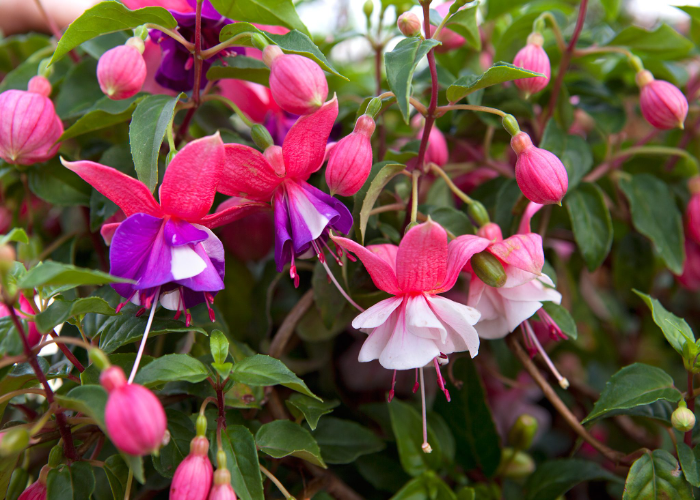
The climbing fuchsia, a fash-growing plant, can grow to a height of 6 feet. To thrive, the climbing fuchsia needs moderate watering and an environment of partial shade to full sun exposure. With its low maintenance requirements, the plant only requires occasional pruning to promote the growth of bushier foliage.
Botanical name: Fuchsia hybrida
Colour option: Climbing beans have the ability to produce a diverse array of colourful flowers, such as-
- Pink
- Red
- Purple
Soil requirement: The climbing fuchsia has a need for well-draining soil that is abundant in organic matter. Though it can germinate in a range of soil types, it thrives best when planted in slightly acidic to neutral soil with a pH of approximately 6.0 to 6.5.
20. Chocolate Vine
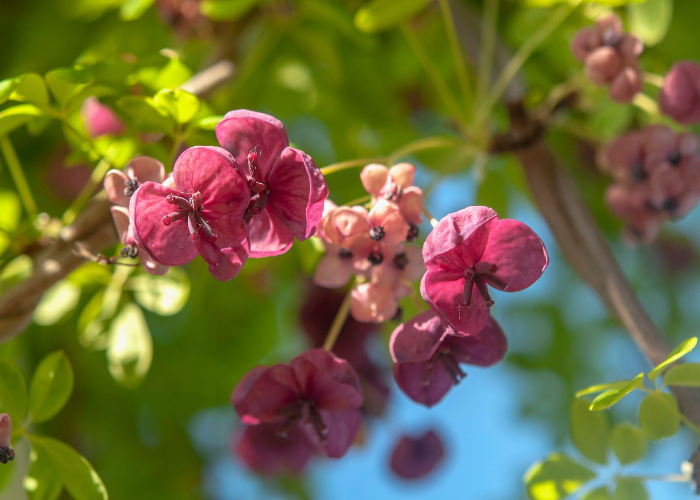
Chocolate Vine is a fast-growing climber. It has the potential to grow up to a height of 20 feet. During the beginning of the warm season, the plant produces aromatic lavender-coloured flowers followed by edible chocolate-like pods. These plants need moderate hydration and full sunshine to partial shadow.
Botanical name: Akebia quinata
Colour option:
- Purple
Soil requirement: The chocolate wine thrives best in soil that has good drainage and is slightly acidic to neutral.
How to Care for Climbing Flowers in The UK?
Nurturing climbing flowers in the UK is relatively easy, although it requires some basic requirements. Primarily, you must ensure that your climbing flower is well-supported, either by a trellis, wall, or fence, to facilitate straight and sturdy growth and to monitor their expansion. Ensuring your climbing plants are frequently watered, particularly during hot, arid weather, is also crucial. Furthermore, you may need to prune your plants regularly to excise any lifeless or marred growth and to promote novel growth. Ultimately, fertilising your climbing plants at consistent intervals is necessary to guarantee they have the necessary nutrients to burgeon robustly and stay hale and hearty.
Final Thoughts
Choosing the appropriate climbing flowers for the garden is of utmost importance when it comes to designing a dynamic and multi-coloured garden. Among the top 20 climbers for Shade, one can find Honeysuckle, Jasmine, Clematis, Wisteria, and Climbing Rose. Gardeners struggle with selecting the ideal climbing plant to choose for their garden as well as the growth circumstances present, which comprise the category of soil and drainage.
For gardeners with a hectic schedule, climbing plants present an amazing option, as they require minimal effort to cultivate and maintain. With a range of colourful selections, these climbers can lift your mood and mesmerising aura of any garden.
Frequently Asked Questions (FAQs)
What Are Some Good Climbing Flowers in The UK?
The United Kingdom has a plethora of many good climbing flowers and plants. A few of them are clematis, climbing rose, passionflower, and honeysuckle, which not only add beauty and vibrance to your garden but also they have an amazing fragrance that will definitely lift your mood.
When Can I Plant Climbing Flowers?
In the majority of cases, you can start planning these flowers in the spring or autumn. During the cooler and damper weather, the soil is optimally prepared for plants to root and establish themselves with greater ease. Conversely, in the spring, as the climate begins to warm up and adopt a mild situation, it is the ideal moment to commence the planting of fresh, new growth.

